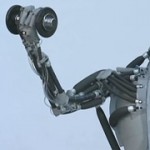Archive for Август, 2007
Designing Safety-Critical Rehabilitation Robots
- Тип контента: Научная статья
- Номер документа: 7146
- Название документа: Designing Safety-Critical Rehabilitation Robots
- Номер (DOI, IBSN, Патент): 978-3-902613-04-2
- Изобретатель/автор: Stephen Roderick, Craig Carignan
- Правопреемник/учебное заведение: University of Maryland, Georgetown University
- Дата публикации документа: 2007-08-31
- Страна опубликовавшая документ: Австрия
- Язык документа: Английский
- Наименование изделия: Не заполнено
- Источник: Rehabilitation Robotics, Book edited by Sashi S Kommu
- Вложения: Да
- Аналитик: Глаголева Елена
 In recent years, robots have made substantial in-roads in the medical field and are gradually finding their way into clinical practice. Intuitive Surgical’s da Vinci surgical robot broke ground in 1998 by performing the first tele-robotic surgery to repair a heart valve (Salis-bury, 1998; Guthart & Salisbury, 2000). Accuray’s CyberKnife radiotherapy robot began treating head, neck and upper spine tumors in 1999 by combining image guidance with a robotically-directed radiation beam (Adler et al., 1997). In 2002, Interactive Motion Technology began therapy of stroke patients with the InMotion2 robot, also known as the MIT-Manus (Krebs et al., 2002). These devices and many others under development have provided researchers and doctors alike with capabilities not previously available.
In recent years, robots have made substantial in-roads in the medical field and are gradually finding their way into clinical practice. Intuitive Surgical’s da Vinci surgical robot broke ground in 1998 by performing the first tele-robotic surgery to repair a heart valve (Salis-bury, 1998; Guthart & Salisbury, 2000). Accuray’s CyberKnife radiotherapy robot began treating head, neck and upper spine tumors in 1999 by combining image guidance with a robotically-directed radiation beam (Adler et al., 1997). In 2002, Interactive Motion Technology began therapy of stroke patients with the InMotion2 robot, also known as the MIT-Manus (Krebs et al., 2002). These devices and many others under development have provided researchers and doctors alike with capabilities not previously available.
Категория: Научные статьи | Нет комментариев »
Создатели руки скопировали анатомию человека
- Тип контента: Новостная статья
- Номер документа: 2263
- Название документа: Создатели руки скопировали анатомию человека
- Номер (DOI, IBSN, Патент): Не заполнено
- Изобретатель/автор: Не заполнено
- Правопреемник/учебное заведение: Не заполнено
- Дата публикации документа: 2007-08-29
- Страна опубликовавшая документ: Россия
- Язык документа: Русский
- Наименование изделия: Не заполнено
- Источник: http://www.membrana.ru/particle/3222
- Вложения: Не заполнено
- Аналитик: Ридна Украина)))
 Фантастика стала ещё на один шажок ближе к реальности. Новая рука для робота — это замечательный пример комбинации принципов биомиметики и мехатроники. Увидев её, кто-то непременно вспомнит Терминатора, но изобретение должно найти массу мирных областей применения.
Фантастика стала ещё на один шажок ближе к реальности. Новая рука для робота — это замечательный пример комбинации принципов биомиметики и мехатроники. Увидев её, кто-то непременно вспомнит Терминатора, но изобретение должно найти массу мирных областей применения.
Категория: Двигатели | Нет комментариев »
Upper-Limb Powered Exoskeleton Design
- Тип контента: Научная статья
- Номер документа: 328
- Название документа: Upper-Limb Powered Exoskeleton Design
- Номер (DOI, IBSN, Патент): 10.1109/TMECH.2007.901934
- Изобретатель/автор: Rosen, J., Perry, J.C., Burns, S.
- Правопреемник/учебное заведение: Washington Univ., Seattle
- Дата публикации документа: 2007-08-20
- Страна опубликовавшая документ: США
- Язык документа: Английский
- Наименование изделия: Не заполнено
- Источник: http://ieeexplore.ieee.org/search/freesrchabstract.jsp?tp=&a
- Вложения: Да
- Аналитик: Дмитрий Соловьев
 An exoskeleton is an external structural mechanism with joints and links corresponding to those of the human body. With applications in rehabilitation medicine and virtual reality simulation, exoskeletons offer benefits for both disabled and healthy populations. A pilot database defining the kinematics and dynamics of the upper limb during daily living activities was one among several factors guiding the development of an anthropomorphic, 7-DOF, powered arm exoskeleton. Additional design inputs include anatomical and physiological considerations, workspace analyses, and upper limb joint ranges of motion. The database was compiled from 19 arm activities of daily living. The cable-actuated dexterous exoskeleton for neurorehabilitation (CADEN)-7 offers remarkable opportunities as a versatile human-machine interface and as a new generation of assistive technology. Proximal placement of motors and distal placement of cable-pulley reductions were incorporated into the design, leading to low inertia, high-stiffness links, and backdrivable transmissions with zero backlash. The design enables full glenohumeral, elbow, and wrist joint functionality. Potential applications of the exoskeleton as a wearable robot include: 1) a therapeutic and diagnostics device for physiotherapy, 2) an assistive (orthotic) device for human power amplifications, 3) a haptic device in virtual reality simulation, and 4) a master device for teleoperation.
An exoskeleton is an external structural mechanism with joints and links corresponding to those of the human body. With applications in rehabilitation medicine and virtual reality simulation, exoskeletons offer benefits for both disabled and healthy populations. A pilot database defining the kinematics and dynamics of the upper limb during daily living activities was one among several factors guiding the development of an anthropomorphic, 7-DOF, powered arm exoskeleton. Additional design inputs include anatomical and physiological considerations, workspace analyses, and upper limb joint ranges of motion. The database was compiled from 19 arm activities of daily living. The cable-actuated dexterous exoskeleton for neurorehabilitation (CADEN)-7 offers remarkable opportunities as a versatile human-machine interface and as a new generation of assistive technology. Proximal placement of motors and distal placement of cable-pulley reductions were incorporated into the design, leading to low inertia, high-stiffness links, and backdrivable transmissions with zero backlash. The design enables full glenohumeral, elbow, and wrist joint functionality. Potential applications of the exoskeleton as a wearable robot include: 1) a therapeutic and diagnostics device for physiotherapy, 2) an assistive (orthotic) device for human power amplifications, 3) a haptic device in virtual reality simulation, and 4) a master device for teleoperation.
Категория: Научные статьи | Нет комментариев »
Investigation of the Use of Humanoids for Industrial Robot Safety Standards
- Тип контента: Научная статья
- Номер документа: 7187
- Название документа: Investigation of the Use of Humanoids for Industrial Robot Safety Standards
- Номер (DOI, IBSN, Патент): Не заполнено
- Изобретатель/автор: Rahul Belur
- Правопреемник/учебное заведение: Winston Churchill High School
- Дата публикации документа: 2007-08-17
- Страна опубликовавшая документ: США
- Язык документа: Английский
- Наименование изделия: Не заполнено
- Источник: Не заполнено
- Вложения: Да
- Аналитик: Глаголева Елена
 It is quite possible that in the future, the Next Generation Robots (NGRs) will work with humans in industrial sectors to lift heavy materials, fetch parts, assist in mounting parts, etc. Gradually the physical safety barriers surrounding these industrial robots will be replaced with virtual barriers such as sensors and safety controllers. The mixing of humans, humanoids, and industrial robots will depend on the safety of the affected workers. This study looks for the availability of humanoid robots, which could be used, to test industrial robots safety systems. Because the study was conducted using public infor-mation, not every field for all the humanoids can be completed.
It is quite possible that in the future, the Next Generation Robots (NGRs) will work with humans in industrial sectors to lift heavy materials, fetch parts, assist in mounting parts, etc. Gradually the physical safety barriers surrounding these industrial robots will be replaced with virtual barriers such as sensors and safety controllers. The mixing of humans, humanoids, and industrial robots will depend on the safety of the affected workers. This study looks for the availability of humanoid robots, which could be used, to test industrial robots safety systems. Because the study was conducted using public infor-mation, not every field for all the humanoids can be completed.
Категория: Научные статьи | Нет комментариев »
Accelerator Exoskeleton
- Тип контента: Научная статья
- Номер документа: 7816
- Название документа: Accelerator Exoskeleton
- Номер (DOI, IBSN, Патент): 10.1535/itj.1103.02
- Изобретатель/автор: Perry Wang, Jamison Collins, Gautham Chinya, Hong Jiang, Xinmin Tian, Milind Girkar, Lisa Pearce, Guei-Yuan Lueh, Sergey Yakoushkin, Hong Wang
- Правопреемник/учебное заведение: Intel Corporation
- Дата публикации документа: 2007-09-22
- Страна опубликовавшая документ: Не заполнено
- Язык документа: Английский
- Наименование изделия: Не заполнено
- Источник: Intel Technology Journal
- Вложения: Да
- Аналитик: Глаголева Елена
 To maximize performance and power efficiency, future multi-core architec-tures may be heterogeneous, incorporating some accelerator cores alongside the IA cores. Accelerator Exoskeletons provide a shared virtual memory heterogeneous multi-threaded programming paradigm for these accelerators using novel CPU instruction set extensions and software tool chains with an Intel Architec-ture (IA) look-n-feel. Firstly, we introduce the proposed architectural extensions known as the Exoskeleton Sequencer (EXO), which represents heterogeneous accelerators as ISA-based MIMD architecture resources, and a shared virtual memory heterogeneous multi-threaded program execution model that tightly couples specialized accelerator cores with general-purpose CPU cores. Then we introduce the C for Heterogeneous Integration (CHI) programming environment that includes a compiler, runtime, debugger, and performance-analysis tools. The CHI compiler extends the OpenMP pragma for heterogeneous multi-threading programming, and it produces a single fat binary with code sections corresponding to different instruction sets. The runtime can judiciously spread parallel computation across the heterogeneous cores to optimize performance and power.
To maximize performance and power efficiency, future multi-core architec-tures may be heterogeneous, incorporating some accelerator cores alongside the IA cores. Accelerator Exoskeletons provide a shared virtual memory heterogeneous multi-threaded programming paradigm for these accelerators using novel CPU instruction set extensions and software tool chains with an Intel Architec-ture (IA) look-n-feel. Firstly, we introduce the proposed architectural extensions known as the Exoskeleton Sequencer (EXO), which represents heterogeneous accelerators as ISA-based MIMD architecture resources, and a shared virtual memory heterogeneous multi-threaded program execution model that tightly couples specialized accelerator cores with general-purpose CPU cores. Then we introduce the C for Heterogeneous Integration (CHI) programming environment that includes a compiler, runtime, debugger, and performance-analysis tools. The CHI compiler extends the OpenMP pragma for heterogeneous multi-threading programming, and it produces a single fat binary with code sections corresponding to different instruction sets. The runtime can judiciously spread parallel computation across the heterogeneous cores to optimize performance and power.
Категория: Научные статьи | Нет комментариев »
Статистика
Категорий: 179
Статей всего: 2,003
По типу:
Видео: 36
Выдержка с форума: 1
Контактные данные: 12
Научная статья: 1388
Не заполнено: 5
Новостная статья: 317
Обзор технологии: 42
Патент: 219
Тех.подробности: 34
Тип: 1
Комментариев: 9,110
Изображений: 3,005
Подробней...
ТОР 10 аналитиков
-
Глаголева Елена - 591
Дмитрий Соловьев - 459
Helix - 218
Ридна Украина))) - 85
Наталья Черкасова - 81
max-orduan - 29
Елена Токай - 15
Роман Михайлов - 9
Мансур Жигануров - 4
Дуванова Татьяна - 3
Календарь
Авторизация
Ошибка в тексте?
Выдели её мышкой!
И нажми Ctrl+Enter